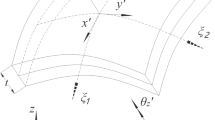Abstract
In ship structural design, many structural analyses by the finite element method are carried out on models at several different scale levels; for example, a whole ship, cargo hold parts, and detailed structures. However, one serious problem with this design and analysis process is that the generation of the finite element models for a complex configuration is very difficult and laborious. To overcome this problem, an object oriented, finite element modeling system, MODIFY, has been developed by the authors. In this paper, the concept of the finite element modeling system and the techniques for the construction of the system are explained. First, the object oriented data structure of the system, based on the Part-Object concept, is proposed. In this concept, not only the geometry of the domain but also the analytical conditions, such as boundary conditions and material properties, and the finite element model, are represented by the object oriented data structure. By using this data structure, effective finite element model generation can be expected. Second, a mesh generation algorithm based on the frontal method is described. The original frontal method by S.H. Lo was improved for application to three-dimensional curved surfaces. A new inner node placement technique to make quadrilateral elements around stress concentrated areas is also proposed. These techniques are suitable for ship structures, and more accurate results from the finite element analysis can be expected. Moreover, the parallel mesh generation is implemented in MODIFY by using the client-server concept to accelerate mesh generation. Third, a prototype system for the automatic finite element model generation for different analysis levels is proposed. The system is based on the concept of the PD part, which is the part in the design and production stage, and automatic computing of the intersection between PD parts. The validity of this system is demonstrated by some examples.
Similar content being viewed by others
References
Kawamura Y, Ohtsubo H, Suzuki K (1994) Finite element mesh generation of ship structures with quadrilateral elements around stress concentrated area (in Japanese). J Soc Nav Arch it Jpn 175:291–298
Kawamura Y, Ohtsubo H, Suzuki K, Tamura H (1994) Development of finite element modeling system for ship structures—solid modeling and object oriented database (in Japanese). J Soc Nav Archit Jpn 176:351–358
Ohtsubo H, Suzuki K, Hiraki T, Kawamura Y (1994) The automatic generation of finite element models for different analysis levels (in Japanese). J Soc Nav Archit Jpn 176:359–365
Mäntylä M (1988) An introduction to solid modeling. Computer Science Press, Rockville
Weiler K (1986) Topological structures in geometric modeling. Ph.D. thesis, Rensselaer Polytechnic Institute, Troy, New York
Xingjian Y (1992) A database design method for finite element analysis. Comput Struct 44(4): 911–914
Objectivity/DB documentation, vols I, II (1991) Objectivity Inc., Mountain View
Ohtsubo H, Kubota A, Kawamura Y (1991) A study on object oriented FEM modeling system for ship structure (in Japanese). J Soc Nav Archit Jpn 170:473–481
Ohtsubo H, Kubota A, Kawamura Y, Hiraki T, Saito M (1992) Development of the object oriented finite element modeling system for 3-D shell structures (in Japanese). J Soc Nav Archit Jpn 172:393–401
Initial Graphics Exchange Specification (IGES), version 3.0 (1986) US Department of Commerce
Lo SH (1985) A new mesh generation scheme for arbitrary planar domains. Int J Num Methods Eng 21:1403–1426
Stevens WR (1990) UNIX network programming. Prentice-Hall, Englewood Cliffs, NJ
Barnhill BE, Kersey SN (1990) A marching method for parametric surface/surface intersection. Comput Aided Geometric Des 7:257–280
Author information
Authors and Affiliations
About this article
Cite this article
Kawamura, Y., Ohtsubo, H. & Suzuki, K. Development of a finite element modeling system for ship structures. J Mar Sci Technol 2, 35–51 (1997). https://doi.org/10.1007/BF01245935
Received:
Accepted:
Issue Date:
DOI: https://doi.org/10.1007/BF01245935




